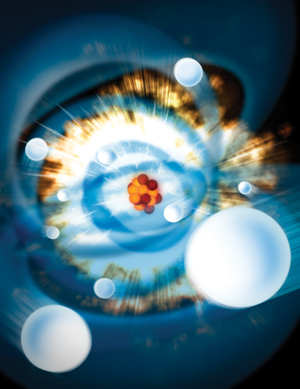First Results from the LCLS: Unpeeling Atoms and Molecules from the Inside Out
Menlo Park, Calif.—The first published scientific results from the world's most powerful hard X-ray laser, located at the
 |
| The world's first hard X-ray free-electron laser started operation with a bang. First experiments at SLAC National Accelerator Laboratory's Linac Coherent Light Source stripped electrons one by one from neon atoms (illustrated above) and nitrogen molecules, in some cases removing only the innermost electrons to create "hollow atoms." Understanding how the machine's ultra-bright X-ray pulses interact with matter will be critical for making clear, atomic-scale images of biological molecules and movies of chemicalprocesses.(Artwork by Gregory Stewart, SLAC.) |
These early results—one published today, the other last week—describe in great detail how the Linac Coherent Light Source's intense pulses of X-ray light change the very atoms and molecules they are designed to image. Controlling those changes will be critical to achieving the atomic-scale images of biological molecules and movies of chemical processes that the LCLS is designed to produce.
In a report published in the July 1 issue of Nature, a team led by Argonne National Laboratory physicist Linda Young describes how they were able to tune LCLS pulses to selectively strip electrons, one by one, from atoms of neon gas. By varying the photon energies of the pulses, they could do it from the outside in or—a more difficult task—from the inside out, creating so-called "hollow atoms."
In another report, published June 22 in Physical Review Letters, a team led by physicist Nora Berrah of Western Michigan University—the third group to conduct experiments at the LCLS—describes the first experiments on molecules. Her group also created hollow atoms, in this case within molecules of nitrogen gas, and found surprising differences in the way short and long laser pulses of exactly the same energies stripped and damaged the nitrogen molecules.
While the first experiments were designed to see what the LCLS can do and how its ultra-fast, ultra-bright pulses interact with atoms and molecules, they also pave the way for more complex experiments to come. Its unique capabilities make the LCLS a powerful tool for research in a wide range of fields, including physics, chemistry, biology, materials and energy sciences.
The LCLS forms images by scattering X-ray light off an atom, molecule or larger sample of material. Yet when the LCLS X-rays are tightly focused by mirrors, each powerful laser pulse destroys any sample it hits. Since certain types of damage, like the melting of a solid, are not instantaneous and only develop with time, the trick is to minimize the damage during the pulse itself and record the X-ray snapshot with a camera before the sample disintegrates.
With all this activity going on inside the atom, scientists have a new way to explore atomic structure and dynamics. Further experiments have investigated nanoclusters of atoms, protein nanocrystals and even individual viruses, with results expected to be published in coming months.
Source: SLAC Website